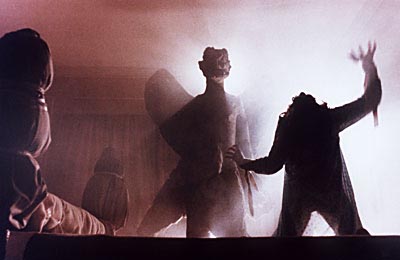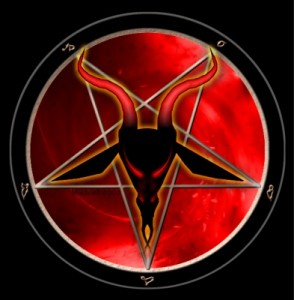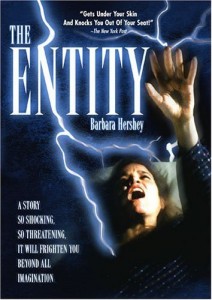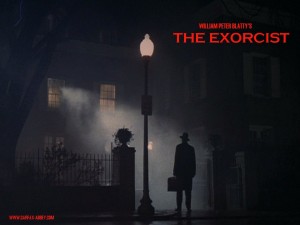 An article that ran in The Telegraph on 7 April titled “Rise in demand for exorcism recalls horror trend,” caught my attention, not only for its connection of concerns over the demonic and contemporary horror films, but also for some of the provocative claims it made. Looking back at The Exorcist (1973) and an increase in the performance of the rite of exorcism by the Roman Catholic Church that came as a result of the novel and film, the article draws similar conclusions in regards to the present through the influence of the Internet and perhaps through contemporary cinema:
An article that ran in The Telegraph on 7 April titled “Rise in demand for exorcism recalls horror trend,” caught my attention, not only for its connection of concerns over the demonic and contemporary horror films, but also for some of the provocative claims it made. Looking back at The Exorcist (1973) and an increase in the performance of the rite of exorcism by the Roman Catholic Church that came as a result of the novel and film, the article draws similar conclusions in regards to the present through the influence of the Internet and perhaps through contemporary cinema:
That trend is now being repeated thanks to the internet according to the Catholic Church. A surge in Satanism fuelled by the web has led to a sharp rise in the demand for exorcists, as information on Devil-worshipping and the occult is at the surfer’s fingertips.
As a result exorcism is now the subject of a six-day conference being held this week at the Regina Apostolorum Pontifical University in Rome, under the authority of the Vatican.
These claims raised red flags for myself and others, and in order to explore this topic I turn to a researcher and colleague, Jesper Aagaard Peterson. Petersen is a Research Fellow at the Dept. of Archaeology and Religious Studies, Norwegian University of Science and Technology. He has published extensively on modern Satanism and is currently finishing his dissertation provisionally entitled “Between Darwin and the Devil: Issues of Articulation and Legitimacy in Contemporary Religious Satanism“.
TheoFantastique: Jesper, thank you for making some time to discuss your research as it relates to current events in popular culture. As you know, an article in The Telegraph in the UK reported on an alleged rise in Satanism, and according to the Roman Catholic Church, a corresponding need for more exorcists as a response to alleged increases in possession. There is a lot to unpack here, but let’s look at the various elements of significance here. To begin, what type of research have you done on Satanism, can you define Satanism in terms of your research, and has there indeed been any kind of rise in Satanism as the article reports?
 Jesper Aagaard Petersen: My research focuses on modern religious Satanism, a heterogeneous assortment of individuals, groups and networks using Satan and other mythological beings as a short-hand for their work on the Left-Hand path. This manifestation of Satanism is recent, only gaining ground and formalization during the occult revival of the 1960s; the most well-known exemplar is of course Anton LaVey’s Church of Satan. Even so, there are many other interpretations alongside LaVey’s – some are atheist and materialist just like the Church, others are explicitly theist, although it often takes a Gnostic or esoteric form rather than a direct mimesis of Christian stereotypes. And there are positions in between. I tend to distinguish ‘rational’ and ‘esoteric’ Satanism as fully developed, autonomous and organized types of religious Satanism. These types should in turn be separated from ‘reactive’ Satanism, which is the (often deeply meaningful, yet fragmented) Satanism of the pact, the teenage bedroom and the black metal concert, and from various demonological discourses on the satanic throughout history.
Jesper Aagaard Petersen: My research focuses on modern religious Satanism, a heterogeneous assortment of individuals, groups and networks using Satan and other mythological beings as a short-hand for their work on the Left-Hand path. This manifestation of Satanism is recent, only gaining ground and formalization during the occult revival of the 1960s; the most well-known exemplar is of course Anton LaVey’s Church of Satan. Even so, there are many other interpretations alongside LaVey’s – some are atheist and materialist just like the Church, others are explicitly theist, although it often takes a Gnostic or esoteric form rather than a direct mimesis of Christian stereotypes. And there are positions in between. I tend to distinguish ‘rational’ and ‘esoteric’ Satanism as fully developed, autonomous and organized types of religious Satanism. These types should in turn be separated from ‘reactive’ Satanism, which is the (often deeply meaningful, yet fragmented) Satanism of the pact, the teenage bedroom and the black metal concert, and from various demonological discourses on the satanic throughout history.
My studies are primarily based on texts, websites and message boards, but I have complemented these sources with both ethnographic, sociological, and media work. What I do is study the discourses and practices of religious groups through the resources and strategies they bring into the struggle to actually define Satanism. As such, I see contemporary Satanism as a satanic milieu of people, organizations, ideas, practices, and channels for communication. This satanic milieu is both separate from and in dialogue with modern occulture and the wider cultural narratives on the satanic. It is distinct, because modern religious Satanism is about the self and not some diabolical ‘other’. The mythological beings used in this identity work have been disembedded from their original context and ‘de-otherized’ (to use Joseph Laycock’s term). Satan and Satanism are no longer solely defined within a Christian context. As such, ‘Satanist’ has followed the same trajectory as ‘witch’, ‘vampire’, ‘pagan, and ‘queer’, to name a few. Rather than positions of (dangerous) inversion, they are now hybrid roles, used within both cultural narratives of the other and as identities for the self. On the other hand, we should acknowledge some dialogue as well. First of all, dark occulture and cultural narratives do work as pathways to and from the satanic milieu, as Satanists engage with both subcultural and mainstream representations and take what they resonate with. Conversely, real Satanists are not totally below the mainstream radar, even if the media representations are sketchy at best and work more along the lines of freak show exhibits. Although I can say with confidence that theories of slippery slopes are mistaken, these relations thus make popular culture one important socialization ‘stage’ for modern Satanists.
Regarding the rise of Satanism, that depends on how you define it. The article you mention calls it a “surge” and a “revival”. It is true that the 1990s and early 2000s saw an increase of interest in Satanism alongside Witchcraft, Neopaganism, and other religious currents with roots in esotericism and occultism. This has to do with the general re-enchantment of the West in the past 50 years (an enchantment that never really went away, actually, but that is another story), which has developed in dialogue with popular media. It is also true that Satanism is more visible and more accessible because of the Internet, and that it flourishes on the de-regulated arenas the Internet provides. On the other hand, membership figures are hard to come by, and should be seen in relation to degrees of affiliation – a majority of witches or Satanists are tourists or dabblers, and only a small minority affiliate with a group and/or develop a long-term engagement. It is likely that more people are attracted to Satanism than before, and they are more visible today, but actual members still amount to thousands and not millions. In any case, where I differ from the article’s conclusion is in the effect of mediated religion on susceptible youth. Watching a movie, accessing a website or participating in a discussion forum does not automatically make you a Satanist, and it certainly does not make you possessed.
TheoFantastique: Is there any reason to make a connection between Satanism in its various forms and the occult and the phenomenon of possession?
Jesper Aagaard Petersen: Well, the simple answer is no. The article in The Telegraph caught my eye, as it fits the recurrent dialectic between real satanic groups on the one hand and anti-satanic discourse on the other, a dialectic covered by for example Phil Jenkins in Mystics and Messiahs (2000). Satanism as a religious option is definitely more visible and has been so since the 1960s witchcraft revival, in no small part because of LaVey’s Satanic Bible and the high media profile of the Church, as well as the meteoric rise of the Internet. On the other hand, the satanic panic and ritual abuse cases of the 1980s and early 1990s did much to reposition anti-satanic discourses of evil as the default interpretation of Satanism. Even though the religious (mainly Evangelical and to a lesser degree Catholic) basis of the moral panic has been exposed, and the secular madness of the media, law enforcement, judicial, education, and social care systems has been criticized extensively, conspiracy and scapegoating remains as a cultural resource. Satanism remains associated with evil in popular discourse and culture.
 That is why I have a problem with the phrase “rise in Satanism” and “occult” in the article. The connotations become conspiratorial and not statistical. The word occult has a specific meaning within Religious Studies tied to the etymology of the word, as hidden. But in popular parlance and Catholic research it has a sinister ring to it. The article posits an causal connection between ease of access and demand for exorcists, but I think a lot of elements are missing from that equation. We have to ask who is searching online and who is in need of an exorcist? Are they even connected? Who makes the connections? There has been a re-enchantment of sorts, and it could of course be interpreted as the work of a cabal of Devil-worshipers influenced by demons. But there is absolutely no reason to see a rise in Satanism, Witchcraft, holistic spirituality and whatnot as anything sinister. Here, modern religious Satanism and the theological discourses on the satanic are two entirely different animals. On the other hand, a higher visibility of things dubbed “occult” and explicitly diabolical might stimulate a higher rate of possession experiences in Evangelical and Catholic communities. Certainly the interpretation of possession is connected to cultural resources at hand. And by extension, possession narratives are in fact reported in movies, talk-shows and so on outside these milieus. But then we have moved our attention to very different arenas of religiosity which is not directly associated with the people I study, namely Christian communities and the ‘secularized’ paranormal demonologies of horror movies (The Entity [1981] or Paranormal Activity [2009], for example).
That is why I have a problem with the phrase “rise in Satanism” and “occult” in the article. The connotations become conspiratorial and not statistical. The word occult has a specific meaning within Religious Studies tied to the etymology of the word, as hidden. But in popular parlance and Catholic research it has a sinister ring to it. The article posits an causal connection between ease of access and demand for exorcists, but I think a lot of elements are missing from that equation. We have to ask who is searching online and who is in need of an exorcist? Are they even connected? Who makes the connections? There has been a re-enchantment of sorts, and it could of course be interpreted as the work of a cabal of Devil-worshipers influenced by demons. But there is absolutely no reason to see a rise in Satanism, Witchcraft, holistic spirituality and whatnot as anything sinister. Here, modern religious Satanism and the theological discourses on the satanic are two entirely different animals. On the other hand, a higher visibility of things dubbed “occult” and explicitly diabolical might stimulate a higher rate of possession experiences in Evangelical and Catholic communities. Certainly the interpretation of possession is connected to cultural resources at hand. And by extension, possession narratives are in fact reported in movies, talk-shows and so on outside these milieus. But then we have moved our attention to very different arenas of religiosity which is not directly associated with the people I study, namely Christian communities and the ‘secularized’ paranormal demonologies of horror movies (The Entity [1981] or Paranormal Activity [2009], for example).
TheoFantastique: I too have noted the continued presence of the devil, possession, and spirit entities in various horror films and television programs. This relates to what has been labeled as popular occulture. Why do you think the devilish in popular occulture is so prevalent, and how might this not be a factor in reports of the need for exorcism?
Jesper Aagaard Petersen: The Devil and his minions certainly sell. They are protean figures that can be molded to fit your narrative needs. And all narratives need bad guys, so why not use the Devil as has been done in popular culture for hundreds of years? Various elements of Christianity are topoi we all recognize (or at least most of us): The savior, the corrupted, the alluring, the end and so on. In addition, social anxieties and the speed of change needs a narrative interpretation. But this is cyclical. The 1960s explosion spawned not only the somewhat eccentric satanic witch of Rosemary’s Baby (1968), but also the unabashedly evil Antichrist of The Omen (1976) and the home invasion of The Exorcist (1973). And then came Michelle Remembers (1980), Multiple Personality Disorders and the MacMartin Preschool. Although thoroughly dismissed, these “real” stories never really went away, they just went back to the milieus from which they emerged, and, crucially, into popular culture as fictional tropes. They also underwent secularization: Aside from explicitly religious demonic fantasies, they continued as spiritual or paranormal narratives. For some two decades, anti-satanism has slumbered, while we have witnessed a resurgence of occultural themes in popular culture and as religious currents. This fin-de-siecle re-enchantment is now met with The Exorcism of Emily Rose (2005), The Last Rite (2010), and The Rite (2011), to name a few recent movies. Hopefully we will stop before the next stage.
 Of course things are more complicated than this. Yet, we have to see re-enchantment, the mainstreaming of occulture and the conservative reaction as parts of a whole. Nevertheless, to argue that movies or the Internet makes demon-possessed victims in need of exorcism is the worst kind of hypodermic needle-argument on the effect of popular culture. We appropriate culture according to need, context and previous experiences. Of course, the Catholic Church has the Devil and his demons pushing the needle, so all constructivist and reception theory arguments are in vain. In a sense, the periodic resurgence of exorcism and other re-enchantment reminds me that we are not that far removed from Hellenistic times. They too ascribed everything to demonic influence, in part because of the changes they experienced.
Of course things are more complicated than this. Yet, we have to see re-enchantment, the mainstreaming of occulture and the conservative reaction as parts of a whole. Nevertheless, to argue that movies or the Internet makes demon-possessed victims in need of exorcism is the worst kind of hypodermic needle-argument on the effect of popular culture. We appropriate culture according to need, context and previous experiences. Of course, the Catholic Church has the Devil and his demons pushing the needle, so all constructivist and reception theory arguments are in vain. In a sense, the periodic resurgence of exorcism and other re-enchantment reminds me that we are not that far removed from Hellenistic times. They too ascribed everything to demonic influence, in part because of the changes they experienced.
TheoFantastique: What kind of conclusions do you draw as a scholar about the kind of sensationalistic and inaccurate reporting in The Telegraph article, as well as that produced by the Catholic Church about this phenomenon?
Jesper Aagaard Petersen: First of all, that causality is still a misunderstood phenomenon. A simultaneous decline in storks and childbirths does not prove that children are brought by long-legged birds. But such “explanations” are easy to sell. Further, it proves that popular accounts of academic research on Satanism and other occultural phenomena are sorely needed. While I have little confidence in the “seriousness and scientific rigour” of the Vatican conference, it obviously has a stronger network in which to promote its views. I might scoff at this article (I did yell at the computer screen when I read it), but it is read by a far wider constituency than any article I have ever written (all of them combined too).
Ultimately, these things move in cycles. In the famous 1972 Time magazine article “The Occult Revival: A Substitute Faith”, many of the same issues are reported. They even comment that the UK is experiencing such a boom in witchcraft and occultism that the Anglicans and Catholics have convened to suggest the appointment of exorcists in each diocese. Sounds oddly familiar in 2011. It is all about social mobilization and the reframing of perceived social problems. The Catholic Church is at odds with a dominant subjectivist trend in modern culture. At times, it tries to accommodate it. At other times, it rejects it and reframes it a social and moral decay. The availability and visibility of Satanism online is an easy target. When connected to the unrelated rise in exorcism movies and popular interest in spirits, demons, and – well, old-school fire and brimstone – a false causality is formed.
TheoFantastique: Jesper, thank you for your time and thoughts on this.
(This interview is also posted at Jesper’s blog.)






2 Responses to “Satanism, Exorcism and Social Horror Trends”